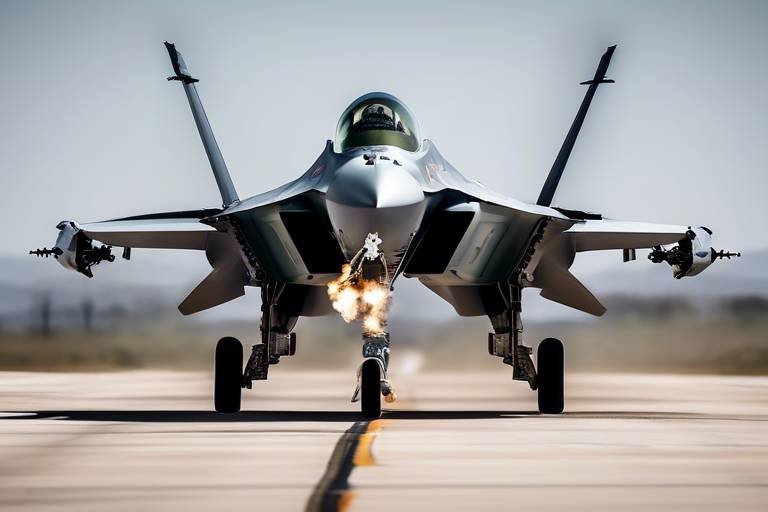An Overview of the USS Gerald R. Ford Aircraft Carrier
The USS Gerald R. Ford (CVN-78) stands as a monumental leap forward in naval engineering and military capability. Launched in 2013 and commissioned in 2017, this aircraft carrier is not just a vessel; it’s a floating fortress designed to dominate the seas and project power across the globe. With its advanced technology and innovative design, the USS Gerald R. Ford is reshaping the landscape of modern naval warfare.
At a staggering length of 1,092 feet and a displacement of over 100,000 tons, the USS Gerald R. Ford dwarfs many of its predecessors. It’s equipped to carry more than 75 aircraft, including the latest fighter jets and unmanned aerial vehicles. Imagine a city at sea, bustling with activity, where every inch is optimized for efficiency and effectiveness. This carrier is designed not only to withstand the rigors of combat but to thrive in them, ensuring that the United States maintains its supremacy on the high seas.
One of the most remarkable features of the USS Gerald R. Ford is its ability to operate with a smaller crew compared to earlier classes of aircraft carriers. Thanks to automation and advanced technology, it requires about 600 fewer personnel, making it more cost-effective in the long run. This reduction in crew size doesn’t compromise safety or effectiveness; instead, it allows for a more agile and responsive operational capability.
But what truly sets the USS Gerald R. Ford apart is its array of cutting-edge systems. From the Electromagnetic Aircraft Launch System (EMALS) to advanced radar systems, this carrier is equipped to handle the demands of modern warfare. The integration of these technologies not only enhances its operational capabilities but also ensures that it can adapt to the ever-evolving landscape of military conflict.
The significance of the USS Gerald R. Ford extends beyond its physical attributes and technological advancements. It symbolizes American resolve and commitment to maintaining peace and stability in turbulent regions around the world. As tensions rise and global threats become more complex, the presence of a carrier like the USS Gerald R. Ford acts as a deterrent, reassuring allies and challenging adversaries. In a world where naval power is synonymous with influence, this aircraft carrier is a key player on the geopolitical chessboard.
In summary, the USS Gerald R. Ford is not just another aircraft carrier; it’s a game-changer. With its state-of-the-art design, advanced technology, and strategic importance, it embodies the future of naval warfare. As we delve deeper into its design, capabilities, and role in modern naval strategies, we will uncover why this vessel is essential for the United States and its allies in the ongoing quest for maritime supremacy.

Design and Specifications
The USS Gerald R. Ford is not just another aircraft carrier; it represents a significant leap forward in naval engineering and design. With a length of approximately 1,106 feet and a displacement of around 100,000 tons, this behemoth is a floating city at sea, capable of accommodating over 4,500 personnel, including aircrew and support staff. The design incorporates a sleek, modern hull shape that enhances its speed and maneuverability, making it a formidable presence on the water.
One of the standout features of the USS Gerald R. Ford is its flight deck, which is designed to handle a larger number of aircraft operations than its predecessors. The flight deck spans about 4.5 acres and is equipped with advanced technologies that facilitate the launch and recovery of various aircraft types. This includes the ability to operate F-35 Lightning II stealth fighters, which represent the cutting edge of military aviation.
In terms of specifications, the USS Gerald R. Ford is powered by two nuclear reactors, allowing it to operate for over a decade without refueling. This remarkable endurance is complemented by its ability to generate enough electricity to power a small town, enabling the use of sophisticated electronic systems and weaponry. Below is a table summarizing some of the key specifications:
| Specification | Details |
|---|---|
| Length | 1,106 feet |
| Displacement | Approximately 100,000 tons |
| Speed | Over 30 knots |
| Crew Size | Approximately 4,500 personnel |
| Aircraft Capacity | 75+ aircraft |
Additionally, the USS Gerald R. Ford introduces innovative features such as the Dual Band Radar, which enhances its situational awareness and target tracking capabilities. This advanced radar system allows the carrier to detect and engage threats more effectively, ensuring the safety of its operations. The integration of stealth technology into the design also reduces its radar cross-section, making it harder for adversaries to detect and target.
Moreover, the carrier's design emphasizes crew comfort and operational efficiency. With improved living quarters, dining facilities, and recreational areas, the USS Gerald R. Ford aims to maintain high morale among its crew during extended deployments. This focus on personnel well-being is essential, as it directly impacts operational readiness and effectiveness.
In summary, the USS Gerald R. Ford is a marvel of modern naval architecture, embodying a blend of advanced technology, thoughtful design, and operational capability. Its specifications not only set a new standard for aircraft carriers but also reflect the evolving needs of naval warfare in the 21st century.

Advanced Technology
The USS Gerald R. Ford is not just another aircraft carrier; it’s a game-changer in naval technology. With its state-of-the-art systems, this floating fortress is designed to enhance operational capabilities in ways previously thought impossible. From advanced radar systems to cutting-edge weaponry, the Ford is equipped to face the challenges of modern warfare head-on. What truly sets it apart is how these technologies work together to create a seamless operational environment that maximizes effectiveness and efficiency.
One of the standout features of the USS Gerald R. Ford is its sophisticated radar systems, which include the AN/SPY-3 Multi-Function Radar. This radar is capable of tracking multiple targets simultaneously, providing real-time data that enhances situational awareness for the crew. Imagine having a 360-degree view of the battlefield, where threats can be detected and neutralized before they even get close. This capability is crucial in today’s fast-paced combat scenarios, where split-second decisions can make all the difference.
But the advanced technology doesn’t stop there. The Ford is also equipped with a variety of weapon systems that are designed to engage threats at various ranges. The ship's armament includes the RIM-162 Evolved SeaSparrow Missile and the Phalanx Close-In Weapon System, both of which provide a robust defense against incoming missiles and aircraft. With these systems, the USS Gerald R. Ford can not only project power but also defend itself against a myriad of threats.
Perhaps the most revolutionary aspect of the USS Gerald R. Ford is its Electromagnetic Aircraft Launch System (EMALS). Unlike traditional steam catapults, EMALS uses electromagnetic technology to launch aircraft from the flight deck. This innovation not only improves launch efficiency but also significantly reduces wear and tear on the aircraft. Think of it as the difference between a gentle push and a violent shove; EMALS provides a smoother, more controlled launch that extends the lifespan of the aircraft.
The benefits of EMALS are numerous and impactful. First, it allows for increased launch rates, meaning more aircraft can be deployed in a shorter time frame. This is crucial during intense combat scenarios where every second counts. Secondly, the reduced maintenance costs associated with EMALS lead to improved operational readiness. With less wear on the aircraft and the system itself, the Ford can remain mission-ready for longer periods, which is a significant advantage in naval warfare.
However, it’s essential to acknowledge that EMALS is not without its challenges. The system has faced technical hurdles during its development and initial deployment phases. Issues such as power fluctuations and the need for precise calibration have raised concerns about its reliability. Additionally, the integration of EMALS into existing naval operations requires extensive training for the crew, which can take time and resources. Despite these challenges, the potential of EMALS to revolutionize aircraft launches is too significant to ignore.
Efficient flight deck operations are the lifeblood of the USS Gerald R. Ford. The design of the flight deck itself incorporates advanced technologies that streamline operations. For instance, the deck features an innovative layout that minimizes the time it takes to move aircraft from the hangar to the launch area. With dedicated pathways and automated systems, the crew can focus on what truly matters: launching and recovering aircraft safely and efficiently. The emphasis on safety is paramount, as the flight deck is one of the most hazardous environments in naval operations.
In conclusion, the advanced technology aboard the USS Gerald R. Ford not only enhances its combat capabilities but also sets a new standard for future aircraft carriers. With innovations like EMALS and state-of-the-art radar systems, the Ford is well-equipped to face the challenges of modern warfare, ensuring that it remains a formidable presence on the high seas.
- What is the primary purpose of the USS Gerald R. Ford?
The primary purpose of the USS Gerald R. Ford is to project power and provide a platform for launching and recovering aircraft, enhancing the United States' naval capabilities. - How does EMALS differ from traditional catapults?
EMALS uses electromagnetic technology to launch aircraft, providing a smoother launch that reduces wear and tear compared to traditional steam catapults. - What are the benefits of the advanced radar systems on the Ford?
The advanced radar systems enhance situational awareness, allowing for tracking multiple targets simultaneously and providing real-time data for decision-making. - What challenges does the USS Gerald R. Ford face?
Some challenges include technical issues with EMALS, the need for extensive crew training, and the integration of new technologies into existing naval operations.

Electromagnetic Aircraft Launch System (EMALS)
The represents a significant leap forward in naval aviation technology. Unlike traditional steam catapults, which have been the standard for decades, EMALS utilizes electromagnetic energy to launch aircraft from the flight deck of the USS Gerald R. Ford. This innovative system not only enhances the efficiency of aircraft launches but also minimizes the wear and tear on the aircraft themselves. Imagine launching a fighter jet with the precision of a roller coaster: smooth, controlled, and powerful. That’s the magic of EMALS!
One of the standout features of EMALS is its ability to adjust the launch speed based on the weight of the aircraft being launched. This adaptability is crucial because it means that whether it’s a lightweight drone or a heavy fighter jet, the launch can be optimized for each specific situation. This tailored approach results in a more effective and safer launch process, reducing the risk of damage to the aircraft. In fact, EMALS can launch a variety of aircraft types, including:
- Fighter jets
- Reconnaissance aircraft
- Transport planes
- Unmanned aerial vehicles (UAVs)
Moreover, EMALS is designed to increase the overall launch rate of aircraft, which is essential during high-intensity operations. The system can launch an aircraft every 60 seconds, significantly enhancing the carrier's operational tempo. This is a game changer in scenarios where rapid response is critical. The ability to efficiently launch multiple aircraft in quick succession allows the USS Gerald R. Ford to maintain air superiority and respond to threats more effectively.
However, like any cutting-edge technology, EMALS is not without its challenges. The transition from steam to electromagnetic systems requires extensive training for personnel, as well as adjustments to existing operational protocols. Additionally, the system's reliance on advanced electronics means that it must be meticulously maintained to avoid potential failures during critical missions. Nevertheless, the U.S. Navy remains committed to overcoming these hurdles, recognizing that the benefits of EMALS far outweigh the initial challenges.
In summary, the Electromagnetic Aircraft Launch System is not just a new way to launch planes; it’s a revolutionary approach that enhances the capabilities of the USS Gerald R. Ford and sets the stage for the future of naval aviation. As we look ahead, it’s clear that EMALS will play a pivotal role in shaping the next generation of aircraft carriers and their operations.

Benefits of EMALS
The Electromagnetic Aircraft Launch System (EMALS) is a game changer for naval aviation, offering several significant advantages over traditional steam catapults. One of the most notable benefits is the increased launch rate. With EMALS, the USS Gerald R. Ford can launch aircraft more quickly and efficiently, enabling it to respond to threats and missions with remarkable agility. Imagine being able to send off multiple jets in a shorter span of time—this capability enhances the carrier's overall operational tempo.
Another crucial benefit is the reduced maintenance costs. Traditional steam catapults require a lot of upkeep due to the wear and tear they experience from launching heavy aircraft. In contrast, EMALS uses a linear motor system that minimizes stress on both the carrier and the aircraft. This not only prolongs the lifespan of the launching equipment but also decreases the frequency and cost of maintenance. The savings can be redirected toward other critical areas, such as crew training or advanced weaponry.
Moreover, EMALS provides a more precise launch mechanism. The system can adjust the launch power based on the specific weight and type of aircraft being launched. This means that whether it's a small drone or a heavy fighter jet, the launch can be tailored for optimal performance. The result? A smoother launch that reduces the risk of accidents and enhances pilot safety. In essence, EMALS transforms the flight deck into a more efficient and safer environment.
In addition to these operational benefits, EMALS also supports a broader range of aircraft types. This flexibility is vital as naval warfare evolves and new aircraft designs are developed. The ability to launch various aircraft without the limitations imposed by steam catapults ensures that the USS Gerald R. Ford remains at the forefront of naval technology.
To summarize, the benefits of EMALS can be encapsulated as follows:
- Increased launch rates for rapid response.
- Reduced maintenance costs leading to better resource allocation.
- Precision launches that enhance safety and efficiency.
- Flexibility to accommodate a wider variety of aircraft.
With these advantages, EMALS not only enhances the operational capabilities of the USS Gerald R. Ford but also signifies a leap forward in naval aviation technology. As the military continues to adapt to modern warfare challenges, systems like EMALS will be essential in maintaining a competitive edge on the high seas.
Q1: What is EMALS?
A1: EMALS stands for Electromagnetic Aircraft Launch System, a technology used to launch aircraft from aircraft carriers, replacing traditional steam catapults.
Q2: How does EMALS improve aircraft launches?
A2: EMALS allows for quicker and more efficient launches, reduces maintenance costs, and provides a more precise launch mechanism tailored to the weight of the aircraft.
Q3: What are the advantages of using EMALS over steam catapults?
A3: The key advantages include increased launch rates, reduced wear on aircraft and equipment, and the ability to launch a wider variety of aircraft types.
Q4: Are there any challenges associated with EMALS?
A4: Yes, while EMALS offers many benefits, it also faces technical and operational challenges that need to be addressed for successful implementation.

Challenges and Limitations
The Electromagnetic Aircraft Launch System (EMALS) on the USS Gerald R. Ford is a groundbreaking innovation, but it doesn't come without its share of challenges and limitations. First, let's talk about the complexity of the system itself. Unlike traditional steam catapults, which have been used for decades, EMALS relies on a series of intricate components and sophisticated software to function effectively. This complexity can lead to potential failures that require extensive troubleshooting and maintenance, which could delay flight operations when time is of the essence.
Another significant challenge is the need for specialized training. Sailors must be well-versed in operating and maintaining EMALS, which means that existing personnel need to undergo rigorous training programs. This can take time and resources, diverting focus from other critical areas of naval operations. The training aspect isn't just about understanding the technology; it's also about adapting to a new operational mindset. The transition from steam to electromagnetic systems represents a fundamental shift in how aircraft are launched, which can be a hurdle for those accustomed to traditional methods.
Moreover, the integration of EMALS with existing aircraft poses its own set of challenges. Not all aircraft are currently designed to take full advantage of EMALS capabilities, which means that modifications may be necessary. This can involve significant engineering work and could lead to increased costs and extended timelines for deployment. The compatibility issues can also extend to logistics and support systems, which must be aligned with the new technology to ensure smooth operations.
Lastly, while EMALS offers many advantages, it is essential to consider the potential for technical glitches during critical missions. The reliance on advanced electronics and software means that any failure could have significant repercussions. In a high-stakes environment, such as naval warfare, the margin for error is razor-thin, and the consequences of a malfunction can be dire. This highlights the need for robust backup systems and contingency plans to mitigate risks associated with the new technology.
In summary, while EMALS represents a leap forward in aircraft launch technology, the challenges and limitations it presents cannot be overlooked. From the complexity of the system and the need for specialized training to the integration with existing aircraft and potential technical glitches, these factors must be carefully managed to ensure the USS Gerald R. Ford can operate at peak efficiency.
- What are the main advantages of EMALS over traditional steam catapults?
EMALS offers improved launch rates, reduced wear on aircraft, and lower maintenance costs. - How does EMALS affect flight deck operations?
EMALS enhances the efficiency of flight deck operations by allowing for quicker and more precise launches. - What challenges does the USS Gerald R. Ford face with EMALS?
The challenges include system complexity, the need for specialized training, aircraft compatibility issues, and the potential for technical glitches. - Is EMALS reliable in high-stakes situations?
While EMALS is designed for reliability, the reliance on advanced technology means that contingency plans are essential to mitigate risks.

Flight Deck Operations
The flight deck of the USS Gerald R. Ford is not just a mere platform for launching and recovering aircraft; it is a bustling hub of activity that operates with military precision. Imagine a complex ballet, where every movement is choreographed to ensure maximum efficiency and safety. The layout and design of the flight deck have been meticulously planned to facilitate rapid aircraft operations, allowing the carrier to project power wherever it is needed. One of the standout features is the use of advanced technologies that streamline these operations, making them more efficient than ever before.
At the heart of flight deck operations is the ability to launch and recover aircraft swiftly. The USS Gerald R. Ford can operate multiple aircraft types, from fighter jets to surveillance planes. This versatility is crucial in modern warfare, where different missions require different aircraft. The flight deck is designed to accommodate various operations simultaneously, which is a game-changer in terms of operational tempo. For instance, while one aircraft is launching, another can be landing, and yet another can be refueling, all happening in a synchronized manner.
To enhance safety and efficiency, the USS Gerald R. Ford employs a series of advanced systems. These include:
- Advanced Lighting Systems: These systems provide optimal visibility during day and night operations, ensuring that the crew can perform their tasks without risk.
- Integrated Deck Management Systems: These systems track aircraft movements and manage flight operations in real-time, reducing the likelihood of accidents.
- Automated Equipment: From aircraft elevators to fueling systems, automation helps minimize human error and increases the speed of operations.
In addition to technology, training plays a crucial role in the success of flight deck operations. Crew members undergo rigorous training to handle the demanding environment of a flight deck. They must be adept at multitasking, quick decision-making, and maintaining clear communication amidst the chaos. This training is not just about learning how to operate machinery; it’s about cultivating a mindset that prioritizes safety and efficiency above all else.
Furthermore, the layout of the flight deck itself is designed to optimize flow and minimize congestion. Aircraft are arranged in a manner that allows for quick access to launch areas while ensuring that landing zones are clear. This thoughtful design reduces the time aircraft spend on the deck, allowing for more launches and recoveries in a shorter period. In essence, the flight deck of the USS Gerald R. Ford is a marvel of modern engineering, where every inch is utilized to maximize operational effectiveness.
As we look to the future, the evolution of flight deck operations will likely continue to integrate even more advanced technologies. With the advent of unmanned aerial vehicles (UAVs) and other high-tech innovations, the USS Gerald R. Ford is poised to remain at the forefront of naval aviation. The carrier's ability to adapt to new technologies and operational concepts will ensure its relevance in the ever-changing landscape of modern warfare.
Q: What is the primary function of the USS Gerald R. Ford's flight deck?
A: The primary function of the flight deck is to launch and recover various types of aircraft, facilitating naval operations and power projection.
Q: How does the USS Gerald R. Ford enhance flight deck safety?
A: The carrier employs advanced lighting systems, integrated deck management systems, and automated equipment to enhance safety and efficiency during flight operations.
Q: What types of aircraft can operate from the USS Gerald R. Ford?
A: The flight deck can accommodate a range of aircraft, including fighter jets, surveillance planes, and unmanned aerial vehicles (UAVs).
Q: How does crew training contribute to flight deck operations?
A: Crew training is essential for preparing personnel to handle the high-pressure environment of the flight deck, focusing on multitasking, decision-making, and communication.

Role in Modern Naval Warfare
The USS Gerald R. Ford is not just an aircraft carrier; it's a floating fortress and a testament to the evolution of naval warfare. In today's complex geopolitical landscape, the role of aircraft carriers has transformed dramatically. They are no longer merely platforms for launching aircraft but are critical components of a nation's power projection strategy. The USS Gerald R. Ford exemplifies this shift with its advanced capabilities, which allow it to operate effectively in a variety of scenarios, from humanitarian missions to full-scale combat operations.
One of the most significant aspects of the USS Gerald R. Ford's role in modern naval warfare is its ability to project power across the globe. This carrier can deploy its air wing, consisting of a variety of aircraft, to engage in operations far from American shores. This capability serves as a deterrent to potential adversaries, signaling that the United States can respond swiftly and decisively to threats. The presence of the USS Gerald R. Ford in a region can change the strategic calculus of nations, as it represents not just military might but also diplomatic influence.
Moreover, the USS Gerald R. Ford plays a crucial role in global security. In an era where threats can arise from state and non-state actors alike, having a powerful naval presence is essential. The carrier's ability to conduct air strikes, provide air support for ground forces, and engage in surveillance and reconnaissance missions makes it a versatile tool in the arsenal of modern warfare. This versatility is enhanced by the carrier's advanced technology, allowing it to operate in contested environments with reduced risk to its crew and assets.
In addition to its combat capabilities, the USS Gerald R. Ford is vital for coalition operations. The carrier can serve as a hub for joint exercises and training missions with allied forces, fostering interoperability and strengthening international partnerships. This is particularly important in today’s interconnected world, where threats are often transnational and require a coordinated response. The carrier's ability to integrate with various naval and air forces enhances collective security and ensures that the United States remains a key player in international affairs.
Furthermore, the USS Gerald R. Ford's role extends beyond traditional military operations. It can also be deployed for humanitarian assistance and disaster relief. When natural disasters strike, the carrier can provide critical support, including medical aid, food, and shelter. Its onboard facilities, such as hospitals and command centers, allow it to respond effectively to crises, showcasing the versatility of modern naval power.
In summary, the USS Gerald R. Ford is a cornerstone of the United States' naval strategy. Its design, capabilities, and operational flexibility make it a formidable asset in modern naval warfare. As we look to the future, the importance of aircraft carriers like the USS Gerald R. Ford will only continue to grow, adapting to the ever-changing dynamics of global security and power projection.
- What makes the USS Gerald R. Ford different from previous aircraft carriers?
Its advanced technology, including the Electromagnetic Aircraft Launch System (EMALS) and enhanced radar systems, sets it apart from earlier models. - How does the USS Gerald R. Ford contribute to global security?
By projecting military power and conducting joint operations with allies, it plays a significant role in maintaining stability and deterring threats. - Can the USS Gerald R. Ford be used for humanitarian missions?
Yes, it has the capabilities to provide disaster relief and humanitarian assistance in times of crisis. - What is the significance of power projection in modern naval warfare?
Power projection allows a nation to influence events and deter adversaries far from its shores, making it a crucial aspect of contemporary military strategy.

Global Presence and Power Projection
The USS Gerald R. Ford is not just a ship; it’s a floating fortress that embodies the strength and resolve of the United States Navy. In an age where global tensions can flare up at any moment, this aircraft carrier serves as a **symbol of American naval power**, projecting influence across the world's oceans. Imagine it as a **guardian of peace**, ready to respond to crises and deter potential adversaries with its formidable presence. The carrier's ability to operate in various environments—from calm seas to tumultuous waters—reinforces its role in maintaining **global security**.
One of the most compelling aspects of the USS Gerald R. Ford is its capacity for **power projection**. This term refers to the ability to deploy military forces to a region in order to deter aggression or respond to conflicts. With its advanced air wing and cutting-edge technology, the Ford can launch a variety of aircraft, including fighter jets, surveillance planes, and drones, all designed to operate seamlessly together. This capability allows the carrier to conduct operations anywhere in the world, making it a key player in the U.S. strategy of **forward presence**.
To illustrate its global reach, consider the following table that highlights the **operational capabilities** of the USS Gerald R. Ford compared to older models:
| Feature | USS Gerald R. Ford | USS Nimitz Class |
|---|---|---|
| Length | 1,092 feet | 1,092 feet |
| Aircraft Capacity | 75+ aircraft | 60+ aircraft |
| Launch System | EMALS | Steam Catapults |
| Maximum Speed | 30+ knots | 30+ knots |
| Crew Size | Approximately 4,500 | Approximately 5,000 |
This table showcases the **significant advancements** that the USS Gerald R. Ford brings to the table, particularly in terms of aircraft capacity and launch systems. The introduction of the **Electromagnetic Aircraft Launch System (EMALS)** means that the Ford can launch more aircraft in less time, enhancing its operational tempo and making it a more effective tool for power projection.
Furthermore, the **global presence** of the USS Gerald R. Ford isn’t just about its physical location; it’s also about the strategic partnerships it fosters. When deployed, the carrier often operates alongside allied naval forces, conducting joint exercises and missions that strengthen international relationships and enhance collective security. This collaboration not only showcases the capabilities of the Ford but also serves as a **deterrent** to potential aggressors who might think twice before challenging a coalition of naval forces.
In summary, the USS Gerald R. Ford is more than just an aircraft carrier; it is a **strategic asset** that plays a crucial role in the United States’ military strategy. By maintaining a robust global presence and demonstrating power projection capabilities, it helps to ensure stability in volatile regions, sending a clear message that the U.S. is committed to defending its interests and those of its allies. As the world continues to change, the USS Gerald R. Ford stands ready to adapt and respond, embodying the future of naval warfare.
- What is the primary function of the USS Gerald R. Ford?
The primary function of the USS Gerald R. Ford is to serve as a mobile airbase, projecting air power and conducting various military operations worldwide. - How does the EMALS system work?
The EMALS system uses electromagnetic fields to launch aircraft, providing a smoother and more efficient launch compared to traditional steam catapults. - What advantages does the USS Gerald R. Ford have over older aircraft carriers?
It has increased aircraft capacity, improved launch systems, and enhanced operational efficiency, making it a more formidable asset in modern naval warfare. - Can the USS Gerald R. Ford operate with allied navies?
Yes, the USS Gerald R. Ford is designed to work seamlessly with allied naval forces, conducting joint exercises and missions to enhance collective security.

Future of Aircraft Carriers
The future of aircraft carriers is a topic that sparks a lot of excitement and debate among military strategists, engineers, and enthusiasts alike. As the USS Gerald R. Ford sets the stage for what modern naval warfare looks like, we can't help but wonder: what comes next? With advancements in technology happening at lightning speed, the evolution of aircraft carriers is bound to be nothing short of revolutionary.
One of the most significant trends we can expect to see is the integration of unmanned aerial vehicles (UAVs). These drones will change the dynamics of carrier operations, allowing for more extensive surveillance and strike capabilities without putting pilots at risk. Imagine a carrier launching a swarm of drones to gather intelligence or conduct precision strikes while the crew manages operations from a safe distance. This shift not only enhances operational safety but also maximizes the efficiency of carrier missions.
Moreover, the push towards green technology will likely play a crucial role in the future of naval vessels, including aircraft carriers. With global warming and environmental concerns at the forefront, navies around the world are exploring ways to reduce their carbon footprint. This could mean the development of carriers powered by alternative energy sources, such as nuclear fusion or advanced biofuels. Such innovations would not only make carriers more sustainable but could also provide them with enhanced operational range and capabilities.
Additionally, we can expect to see enhanced automation in carrier operations. With AI and machine learning technology advancing rapidly, the potential for automating various functions aboard a carrier is immense. From flight deck operations to maintenance and logistics, automation could streamline processes and reduce human error, ultimately leading to more effective and efficient missions. The USS Gerald R. Ford already incorporates some level of automation, but future carriers may take this to a whole new level.
Another exciting prospect is the use of advanced materials in the construction of aircraft carriers. The introduction of lighter and stronger materials, such as carbon fiber composites, could lead to carriers that are not only more durable but also more agile. This would allow for improved maneuverability and potentially enable carriers to operate in more challenging environments. Imagine a carrier that can withstand extreme weather conditions while maintaining its operational readiness—this could be the future of naval warfare!
As we look ahead, we also have to consider the strategic implications of these advancements. The evolution of aircraft carriers will undoubtedly reshape global naval power dynamics. Countries that invest in cutting-edge carrier technology may gain a significant edge in maritime dominance. As such, we might see a new arms race focused on naval capabilities, particularly in the Asia-Pacific region, where tensions are already high.
In conclusion, the future of aircraft carriers is poised to be a thrilling journey filled with innovation and transformation. The USS Gerald R. Ford is just the beginning, acting as a catalyst for change. With advancements in unmanned systems, green technology, automation, and materials science, the next generation of aircraft carriers will not only redefine naval warfare but also ensure that they remain a cornerstone of national security for years to come.
- What is the primary role of aircraft carriers in modern warfare?
Aircraft carriers serve as mobile airbases that project power and provide air support for military operations. - How does the USS Gerald R. Ford differ from older carriers?
The USS Gerald R. Ford features advanced technologies such as the Electromagnetic Aircraft Launch System (EMALS) and improved radar systems. - What advancements can we expect in future aircraft carriers?
Future carriers are likely to incorporate unmanned vehicles, green technologies, enhanced automation, and advanced materials.
Frequently Asked Questions
- What is the USS Gerald R. Ford?
The USS Gerald R. Ford is a next-generation aircraft carrier of the United States Navy, designed to enhance naval warfare capabilities. It is equipped with advanced technology and innovative design features that set it apart from previous carriers.
- What are the key specifications of the USS Gerald R. Ford?
This aircraft carrier boasts a length of 1,106 feet, a displacement of approximately 100,000 tons, and can carry around 75 aircraft. Its design incorporates a flight deck that allows for more efficient operations and increased sortie rates.
- How does the Electromagnetic Aircraft Launch System (EMALS) work?
EMALS uses electromagnetic forces to launch aircraft from the carrier, replacing traditional steam catapults. This system allows for smoother launches and reduces wear and tear on both the aircraft and the launching mechanisms.
- What are the benefits of using EMALS?
EMALS offers several advantages, including higher launch rates, reduced maintenance costs, and the ability to launch a wider variety of aircraft. This enhances the operational readiness of the USS Gerald R. Ford and improves its overall efficiency.
- What challenges does EMALS face?
Despite its benefits, EMALS encounters challenges such as technical difficulties and the need for extensive training for crew members. Overcoming these hurdles is essential for the successful integration of this system into carrier operations.
- How does the USS Gerald R. Ford optimize flight deck operations?
The carrier utilizes advanced technologies and streamlined procedures to enhance flight deck safety and efficiency. This includes improved systems for handling aircraft and coordinating launch and recovery operations.
- What is the role of the USS Gerald R. Ford in modern naval warfare?
The USS Gerald R. Ford plays a crucial role in power projection and global security. Its presence serves as a deterrent to potential threats and reinforces the United States' commitment to maintaining peace and stability in various regions.
- What does the future hold for aircraft carriers like the USS Gerald R. Ford?
The evolution of aircraft carriers is ongoing, with advancements in technology and design expected to shape the future of naval warfare. The USS Gerald R. Ford is at the forefront of these developments, paving the way for the next generation of carriers.



















